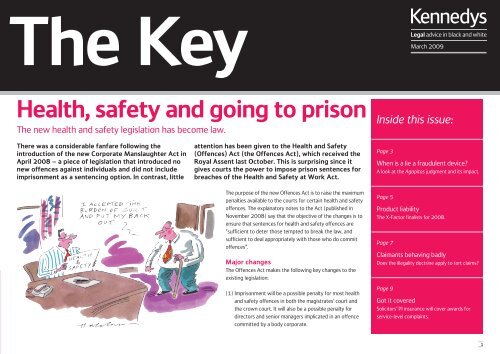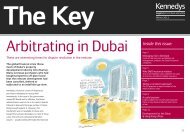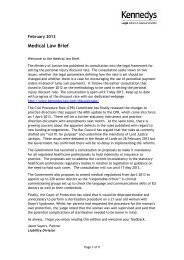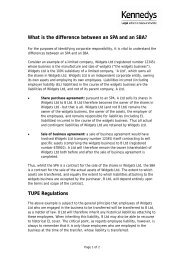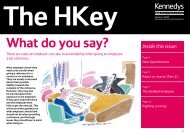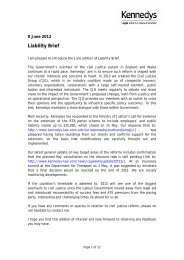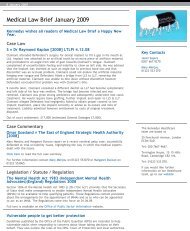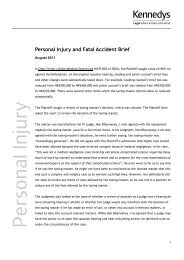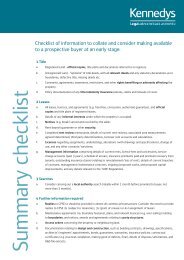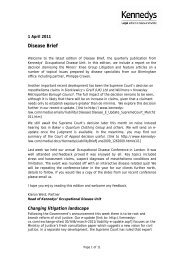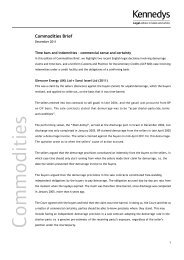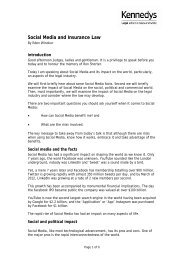Download The Key - Spring 2009 (PDF, 1.04MB). - Kennedys
Download The Key - Spring 2009 (PDF, 1.04MB). - Kennedys
Download The Key - Spring 2009 (PDF, 1.04MB). - Kennedys
You also want an ePaper? Increase the reach of your titles
YUMPU automatically turns print PDFs into web optimized ePapers that Google loves.
<strong>The</strong> <strong>Key</strong><br />
March <strong>2009</strong><br />
Health, safety and going to prison<br />
<strong>The</strong> new health and safety legislation has become law.<br />
Inside this issue:<br />
<strong>The</strong>re was a considerable fanfare following the<br />
introduction of the new Corporate Manslaughter Act in<br />
April 2008 – a piece of legislation that introduced no<br />
new offences against individuals and did not include<br />
imprisonment as a sentencing option. In contrast, little<br />
attention has been given to the Health and Safety<br />
(Offences) Act (the Offences Act), which received the<br />
Royal Assent last October. This is surprising since it<br />
gives courts the power to impose prison sentences for<br />
breaches of the Health and Safety at Work Act.<br />
<strong>The</strong> purpose of the new Offences Act is to raise the maximum<br />
penalties available to the courts for certain health and safety<br />
offences. <strong>The</strong> explanatory notes to the Act (published in<br />
November 2008) say that the objective of the changes is to<br />
ensure that sentences for health and safety offences are<br />
“sufficient to deter those tempted to break the law, and<br />
sufficient to deal appropriately with those who do commit<br />
offences”.<br />
Major changes<br />
<strong>The</strong> Offences Act makes the following key changes to the<br />
existing legislation:<br />
(1) Imprisonment will be a possible penalty for most health<br />
and safety offences in both the magistrates’ court and<br />
the crown court. It will also be a possible penalty for<br />
directors and senior managers implicated in an offence<br />
committed by a body corporate.<br />
Page 3<br />
When is a lie a fraudulent device?<br />
A look at the Agapitos judgment and its impact.<br />
Page 5<br />
Product liability<br />
<strong>The</strong> X-Factor finalists for 2008.<br />
Page 7<br />
Claimants behaving badly<br />
Does the illegality doctrine apply to tort claims?<br />
Page 9<br />
Got it covered<br />
Solicitors’ PI insurance will cover awards for<br />
service-level complaints.<br />
1
(2) <strong>The</strong> maximum fine available in the<br />
magistrates’ court for regulatory breaches,<br />
instead of or in addition to imprisonment, has<br />
been increased from £5,000 to £20,000.<br />
(3) Certain offences currently triable only in the<br />
magistrates’ court will be triable in either<br />
the magistrates’ court or the crown court.<br />
Currently, employees can be prosecuted for a<br />
breach of section 7 of the Health and Safety at<br />
Work Act. This statutory provision places a duty<br />
on employees to take reasonable care for<br />
themselves and others affected by their acts or<br />
omissions. In addition, senior managers and<br />
directors can be convicted under section 37<br />
where it can be proved that an offence by the<br />
company was committed with their consent,<br />
connivance or attributable to some neglect on<br />
their part. In future, individuals convicted of such<br />
offences face the risk of going to jail.<br />
This is not the first time that such legislation has<br />
been proposed. <strong>The</strong>re have been three previous<br />
attempts to introduce almost identically worded<br />
private members’ bills since 1999, when the<br />
government introduced its Revitalising Health<br />
and Safety strategy, which recommended new<br />
penalties for offences. However, these earlier<br />
attempts failed because the government did not<br />
provide sufficient parliamentary support or,<br />
crucially, time. <strong>The</strong>re were also objections to the<br />
principle of the legislation. <strong>The</strong> difference this<br />
time was that the government gave time for the<br />
offences bill, which enjoyed all-party support.<br />
Need for reform<br />
In a letter accompanying the offences bill, the<br />
government explained that the law needed to<br />
be reformed so as to bring health and safety<br />
offences into line with regulatory offences in<br />
other areas. It was strange, the letter concluded,<br />
that people could go to prison for breaches of<br />
environmental, trading standards, planning,<br />
water resources and food safety rules but not for<br />
health and safety offences.<br />
This is something the courts have long recognised.<br />
For example, as long ago as 1994, in the case of<br />
R v Baldwin Industrial Services Ltd, Judge Bathurst<br />
Norman (sitting at Isleworth Crown Court) said of<br />
Mr Baldwin, a company director: “I make no secret<br />
of the fact that were prison an option that was<br />
open to me today, you would be going to prison...<br />
I hope that one day [parliament] will look again<br />
at this legislation and will amend it so that the<br />
sentencing judge has available to him the<br />
option of a custodial sentence”.<br />
Perhaps the biggest surprise is that it has taken<br />
14 years for the judge’s aspiration to be realised.<br />
In the letter accompanying the offences bill, the<br />
government cited (as examples of health and<br />
safety breaches possibly meriting custodial<br />
sentences) cases where an employer illegally<br />
employed children for the removal of asbestos,<br />
or where there was deliberate fabrication of test<br />
certificates for cranes and other machinery.<br />
Most reasonable observers would agree that this<br />
type of conduct should carry the possibility of<br />
imprisonment on conviction. However, it is vitally<br />
important to get the details right, so that the<br />
Offences Act can be fairly and equitably<br />
enforced. Imprisonment should therefore be<br />
reserved for the most serious of cases where<br />
there is evidence either of wilful conduct or a<br />
flagrant or reckless disregard for safety.<br />
Reverse burden of proof<br />
<strong>The</strong>re is also one significant difficulty with the<br />
Offences Act that had not until recently been<br />
addressed. <strong>The</strong> offence for senior managers and<br />
directors under section 37 is based on the<br />
prosecution being able to prove that a defendant<br />
consented to, connived in or (by neglect) caused<br />
the commission of the offence by their company.<br />
<strong>The</strong> main offences usually prosecuted against<br />
companies are for breaches of sections 2 and 3<br />
of the HSWA. Both of these provisions contain a<br />
reverse burden – set out at section 40 –<br />
meaning that, once a risk has been established, a<br />
company effectively has to prove its innocence<br />
by showing that it took all reasonably practicable<br />
steps to ensure safety.<br />
According to the explanatory notes to the offences<br />
bill, the Department for Work and Pensions<br />
considers that making imprisonment available for<br />
an offence to which the reverse burden of proof<br />
applies is compatible with article 6 of the European<br />
Convention on Human Rights (i.e. the right to be<br />
treated as innocent until proven guilty).<br />
This was a little difficult to understand. <strong>The</strong><br />
difference in evidential burden creates a<br />
presumption of guilt rather than one of<br />
innocence. In this context, the use of<br />
imprisonment as a penalty appears at first glance<br />
to be both contrary to the principles of justice<br />
under the British legal system as well as against<br />
the European Convention on Human Rights.<br />
In R v Davies [2002] EWCA Crim 2949, the<br />
Court of Appeal considered the compatibility of<br />
the section 40 reverse burden with the ECHR. <strong>The</strong><br />
defendant in that case argued that, unless the<br />
reverse burden was an evidential burden alone, it<br />
would not be compatible with the presumption of<br />
innocence in article 6.2 of the ECHR. <strong>The</strong> Court of<br />
Appeal rejected this argument, concluding that<br />
the burden was a legal or persuasive burden and<br />
justified, necessary or proportionate in the<br />
context of the Convention. However, the court<br />
reached this view on the basis that the health and<br />
safety legislation was regulatory rather than “truly<br />
criminal”, in part because breach of the relevant<br />
sections of the HSWA did not carry a risk of<br />
imprisonment.<br />
By making the HSWA breach “truly criminal”,<br />
the new Offences Act had therefore partially<br />
undermined the rationale of the Court of<br />
Appeal’s decision that section 40 was<br />
compatible with the ECHR. This could easily have<br />
been corrected by imposing a specific duty on a<br />
director to take reasonable care for people who<br />
may be affected by his or her work, similar to the<br />
duty on employees under section 7. <strong>The</strong> entirety<br />
of the offence could then have been subject to<br />
proof to the usual criminal standard of beyond all<br />
reasonable doubt.<br />
A decision of the House of Lords in December<br />
2008, however, in the case of R v Chargot Ltd<br />
[2008] UKHL 73, is likely to mean that senior<br />
managers and directors charged with<br />
involvement in offences committed by their<br />
companies may now struggle to challenge the<br />
section 40 reverse burden. In the leading<br />
judgment in that case, Lord Hope revisited the<br />
Court of Appeal’s rationale in R v Davies and<br />
confirmed that it had reached the right decision.<br />
Further, he went on:<br />
“<strong>The</strong> penalties that may be imposed on an<br />
individual have now been increased… But I do not<br />
think that, when account is taken of the purposes<br />
that this legislation is intended to serve, this<br />
alteration to the law renders what was previously<br />
proportionate disproportionate… On the contrary,<br />
it emphasises the importance that is attached, in<br />
the public interest, to the performance of the duty<br />
that section 37 imposes on the officer”.<br />
2
So the House of Lords has now given a steer on<br />
the point. Whether or not that steer is clear and<br />
unambiguous is perhaps open to argument.<br />
Conclusion<br />
From January <strong>2009</strong>, the Offences Act will have a<br />
significant impact on the liability of directors and<br />
officers in the UK, as well as on employees. Up to<br />
now, most health and safety offences under the<br />
HSWA could only be punished with a fine. Now<br />
directors and other company officers (along<br />
with all employees) face the possibility of<br />
imprisonment for such a breach of duty. This<br />
threat to their liberty is likely to make them seek<br />
to fight allegations of failure even more fiercely<br />
than previously, notwithstanding the fact that<br />
one potential “legal” argument may no longer be<br />
entirely open to them. It is also now important<br />
more than ever for directors and company<br />
officers to have proper insurance provision for<br />
their health and safety liability.<br />
Finally, while the principle behind the Offences<br />
Act can generally be supported, the withdrawal<br />
of an individual’s right of liberty is such a serious<br />
penalty that there should, at the very least, be<br />
clear sentencing guidance stressing that<br />
imprisonment must be imposed only in the very<br />
worst cases.<br />
<strong>The</strong> Health and Safety (Offences) Act covers<br />
offences committed after 16 January <strong>2009</strong>.<br />
Daniel McShee<br />
London<br />
d.mcshee@kennedys-law.com<br />
David Wright<br />
London<br />
d.wright@kennedys-law.com<br />
When is a lie a fraudulent device?<br />
A look at the Agapitos judgment and its impact.<br />
<strong>The</strong>re are many grounds on which<br />
an insurer can avoid having to meet<br />
a claim under a policy: nondisclosure;<br />
misrepresentation;<br />
breach of warranty or condition<br />
precedent; or fraud by the insured.<br />
What constitutes a fraudulent claim<br />
is well understood: a claim for a<br />
loss that did not occur, or which<br />
was caused or procured by the<br />
insured, or alternatively, a genuine<br />
claim that has been exaggerated.<br />
<strong>The</strong>re are ways in which an insurer can avoid a<br />
genuine-looking claim where it has considerable<br />
concerns about the insured’s story, even though<br />
it is unable to prove the kinds of wrongdoing<br />
outlined above. An insured’s lies to an<br />
investigator – told, perhaps, to conceal<br />
wrongdoing or a defence that might be available<br />
to an insurer, or to embellish an account about<br />
which the insured has anxieties – may, in<br />
themselves, defeat the insurance claim. This<br />
issue was explored by the Court of Appeal in<br />
Agapitos v Agnew [2003] QB 556. In giving<br />
the leading judgment (with which Lord Justice<br />
Brooke and Mr Justice Park agreed), Lord Justice<br />
Mance noted that ‘such devices’ are a not<br />
unfamiliar response to insurers’ probing of the<br />
merits of a claim.<br />
Fraudulent devices<br />
Strictly speaking, Lord Justice Mance’s<br />
observations in Agapitos on “fraudulent means<br />
and devices” (meaning a fraud where an insured<br />
gives a false statement to embellish or improve<br />
the surrounding facts of a genuine claim) were<br />
expressed to be a tentative view and that they<br />
have been followed and approved by both the<br />
judiciary and commentators.<br />
If a claim is found to be fraudulent, the insurer<br />
can avoid liability for that claim and any<br />
subsequent claim made under the same policy,<br />
even if the subsequent claim is genuine. Should<br />
the same remedy be available when it comes to<br />
otherwise genuine claims where the policyholder<br />
tells lies to the insurer?<br />
It is not any lie, though, that will give an insurer a<br />
remedy. Lord Justice Mance contemplated “the<br />
possibility of an obviously irrelevant lie”. <strong>The</strong> fraud,<br />
he said, must be “directly related to and intended<br />
to promote the claim”. In such a case, the usual<br />
reason for the use of a fraudulent device “will have<br />
been concern by the insured about [the]<br />
prospects of success and desire to improve them<br />
by presenting the claim on a false factual basis”.<br />
3
Lord Justice Mance then turned to the question<br />
of the appropriate legal response to a fraudulent<br />
device used to promote a claim “which may…<br />
prove at trial to be otherwise good, but in<br />
relation to which the insured feels it expedient<br />
to tell lies to improve his prospects of settlement<br />
or at trial”.<br />
Giving a tentative answer to the question, Lord<br />
Justice Mance said that the law should treat the<br />
use of a fraudulent device “as a subspecies of<br />
making a fraudulent claim – at least as regards<br />
forfeiture of the claim itself in relation to which<br />
the fraudulent device or means is used”. For this<br />
purpose, the law should treat as relevant any lie:<br />
• directly related to the claim to which the<br />
fraudulent device relates; and<br />
• which is intended to improve the insured’s<br />
prospects of obtaining a settlement or<br />
winning the case; and<br />
• which would, if believed, tend “to yield a<br />
not insignificant improvement in the<br />
insured’s prospects… for obtaining a<br />
settlement, or a better settlement, or of<br />
winning at trial”.<br />
In Wisenthal v World Auxiliary Insurance<br />
Corporation (1930) 38 Ll L Rep 54, Mr Justice<br />
Roche told the jury: “Fraud… was not merely<br />
lying. It was seeking to obtain an advantage,<br />
generally monetary, or to put someone else at<br />
a disadvantage by lies and deceit. It would be<br />
sufficient, within the definition of fraud, if the<br />
jury thought that, in the investigation, deceit<br />
had been used to secure payment or quicker<br />
payment of the money that would have been<br />
obtained if the truth had been told”.<br />
So a lie to an investigator that is intended to<br />
improve the likelihood of the claim being paid,<br />
the amount of the payment or the speed of the<br />
payment is likely to constitute a “fraudulent<br />
device”. Any such false statement will give the<br />
insurer a strong weapon to defeat the claim.<br />
An insurer does not have to show that:<br />
• it was persuaded by the lie into taking<br />
action; or<br />
• that the lie was an attempt by the insured<br />
to conceal grounds on which the insurer<br />
could decline or limit the claim (although<br />
that would still be one reason to categorise<br />
a lie as a fraudulent device).<br />
<strong>The</strong> insurer can rely on lies told by the insured’s<br />
agents or representatives. However, it cannot<br />
rely on lies told after the start of legal<br />
proceedings, as the rules relating to contempt of<br />
court take over at that point.<br />
What’s happened since Agapitos?<br />
How have the courts dealt with lies to insurers<br />
since the Agapitos case? <strong>The</strong> short answer is<br />
that there have been very few reported cases on<br />
this point. This is surprising, given Lord Justice<br />
Mance’s observation that deceitful statements<br />
to insurers’ investigators “are a not unfamiliar<br />
response” to investigations.<br />
In Eagle Star Insurance v <strong>The</strong> Games Video<br />
Company (GVC) SA [2004] EWHC 15, which<br />
concerned the destruction of a ship, the insurer<br />
avoided having to indemnify the owner of the<br />
vessel. During the course of the insurer’s<br />
investigation into the cause of the loss, the<br />
vessel owners presented fabricated documents<br />
about the supposed nature and value of the<br />
ship. <strong>The</strong> court concluded that these documents<br />
had been created and presented to try and<br />
bolster what the vessel owners had said about<br />
the ship’s value: “<strong>The</strong>y were asked for<br />
documents”, said Mr Justice Simon, “and they<br />
handed over the documents whose contents<br />
were deceitful. <strong>The</strong>y used fraudulent devices in<br />
order to advance the claim, with the intention<br />
and expectation that the insurer would accept<br />
the documents at face value, be reassured and<br />
promptly pay the assureds”.<br />
<strong>The</strong> Commercial Court in Marc Rich Agriculture<br />
Trading SA v Fortes Corporate Insurance NV<br />
[2004] EWHC 2632 (QB) responded<br />
favourably to the insured’s argument: an alleged<br />
failure by the insured to disclose information to<br />
an insurer did not constitute a fraudulent device.<br />
In recognising that Lord Justice Mance’s<br />
comments in Agapitos were incidental rather<br />
than central to the decision – and given the<br />
developing nature of the relevant law –<br />
Mr Justice Cooke in Marc Rich dismissed the<br />
insured’s application for summary judgment on<br />
certain aspects of the insurer’s defence.<br />
However, the judge went on to say that “were<br />
the matter to come before me at trial, my<br />
inclination would be to say that Lord Justice<br />
Mance is right in the approach that he has<br />
adopted”. Mr Justice Cooke would prefer the<br />
insured’s arguments on non-disclosure during<br />
the insurer’s investigations.<br />
In Stemson v AMP General Insurance (NZ) Ltd<br />
[2006] UKPC 30, the Privy Council allowed the<br />
insurer to rely on a fraudulent device defence.<br />
Following a fire at the insured property, the<br />
insured lied to the investigator about his<br />
intention to sell the property. That was a<br />
fraudulent device and remained so even though<br />
the insured admitted his true intention before<br />
the insurer’s rejection of the claims.<br />
Handling and assessing lies<br />
As has been shown in both the law courts and in<br />
numerous surveys, many people are willing to lie<br />
to insurers. <strong>The</strong> Agapitos case provides a<br />
powerful response to people who tell lies to<br />
insurers during investigation.<br />
At a practical level, it is important for<br />
investigators to keep thorough and detailed<br />
records of their communications with insureds.<br />
Audio recordings are often useful. Wherever<br />
possible, verbal statements should be confirmed<br />
in written statements, signed if possible, or in<br />
confirmatory letters to the insured. Investigators’<br />
notes of conversations should be accurate,<br />
legible, timed and dated, and stored securely. As<br />
was shown in the Eagle Star case, fraudulent<br />
devices can take the form of fabricated<br />
documents; all documents received from the<br />
insureds or their representatives must be kept<br />
securely and with a record of when they were<br />
received.<br />
In addition to the storing and recording of<br />
communications, it is vitally important that such<br />
communications are reviewed in the light of<br />
material received subsequently.<br />
However, as Lord Justice Mance stressed in<br />
Agapitos, it is not every lie that will constitute a<br />
fraudulent device. Consequently, where lies are<br />
detected, their purpose and intended effect<br />
must be considered carefully.<br />
Robert Welfare<br />
Birmingham<br />
r.welfare@kennedys-law.com<br />
4
Product liability<br />
<strong>The</strong> X-Factor finalists for 2008.<br />
Credit-crunched 2008 saw a<br />
further rise in product recalls – as<br />
well as interesting regulatory<br />
changes in the product liability<br />
field. This article highlights the<br />
most significant developments in<br />
England and examines their impact<br />
on their audience of consumers,<br />
manufacturers and insurers in order<br />
to find the X-Factor winner.<br />
X-Factor finalist 1: the Statement<br />
<strong>The</strong> first finalist is a solo act statement<br />
released by the Financial Services Agency (the<br />
FSA) on 25 July 2008. <strong>The</strong> statement warns<br />
that clauses in general insurance contracts,<br />
which use the phrase “consequential loss” may<br />
be unfair and in breach of the Unfair Terms in<br />
Consumer Contract Regulations 1999 (the<br />
UTC regulations).<br />
Under the UTC regulations, firms must ensure<br />
that all terms of a standard-form consumer<br />
contract are in plain and intelligible language.<br />
<strong>The</strong> FSA’s view is that a term excluding<br />
consequential loss is “unclear” and “ambiguous”<br />
because it refers to a legal expression that a<br />
consumer would not understand. <strong>The</strong> FSA<br />
believes that this can lead to “a significant<br />
imbalance in the parties’ rights and obligations<br />
arising under the contract, to the detriment of the<br />
consumer” since it leaves the consumer not<br />
knowing what the policy covers.<br />
As a result, any consequential loss exclusions<br />
that are not written in plain and intelligible<br />
language will now be considered unfair. Insurers<br />
may therefore have to make payments in respect<br />
of the loss they have tried to exclude.<br />
<strong>The</strong> FSA gave the following example of a term<br />
that excludes consequential loss without using<br />
that particular phrase: “We will only pay costs<br />
which are incurred as a direct consequence of<br />
the event which led to the claim you are making<br />
under the policy”.<br />
Insurance firms should therefore review their<br />
consequential loss exclusions to ensure that<br />
they are plain and intelligible. <strong>The</strong>y should also<br />
regularly assess their terms and conditions to<br />
ensure that they meet the standards of fairness<br />
set out in the UTC regulations, and take any<br />
necessary steps to ensure compliance.<br />
X-Factor finalist 2: the Regulations<br />
<strong>The</strong> second finalist is a double act known as<br />
the Consumer Protection from Unfair Trading<br />
Regulations 2008 (the CPUT regulations)<br />
and the Business Protection from Misleading<br />
Marketing Regulations 2008 (the BPMM<br />
regulations).<br />
Both sets of regulations came into force on<br />
26 May 2008 implementing the EU’s Unfair<br />
Commercial Practices Directive and criminalising<br />
misleading marketing and sales practices.<br />
<strong>The</strong> CPUT regulations primarily aim to protect<br />
consumers from unfair trading. For example, if<br />
an advertisement claims that a beauty product<br />
can clear a consumer’s acne when it doesn’t, that<br />
would be a breach of the CPUT regulations.<br />
<strong>The</strong> BPMM regulations, on the other hand, are<br />
mainly concerned with protecting other traders.<br />
Advertising that is likely to deceive the trader<br />
whom it reaches would be an offence. <strong>The</strong><br />
regulations also set out the conditions that must<br />
be fulfilled before an advertisement comparing<br />
one particular product with that of an identified<br />
competitor will be regarded as acceptable.<br />
5
Investigations will be carried out by the Office of<br />
Fair Trading, as well as local authorities, and<br />
offenders face a fine of up to £5,000 or two<br />
years’ imprisonment. Companies should<br />
therefore reassess their marketing and<br />
advertising practices in the light of these<br />
regulations before they get caught.<br />
X-Factor finalist 3: the Rules<br />
<strong>The</strong> third finalist is a group of rules known as the<br />
Coroners (Amendment) Rules 2008, which<br />
came into force on 17 July last year.<br />
Under rule 43 of the Coroners Rules 1984, in order<br />
to prevent a similar death to the one in question, a<br />
coroner has a discretion to submit a written report<br />
(a rule 43 report) to an authority or individual who<br />
may have the power to take appropriate action.<br />
If any company finds itself potentially involved in<br />
a coroner’s hearing, it should obtain suitable<br />
advice on how to participate and protect its<br />
interests, given the importance of these new<br />
powers of coroners.<br />
X-Factor finalist 4: the Recalls<br />
<strong>The</strong> fourth finalist is a further group entry known<br />
simply as PR – but it is made up of the three<br />
sexiest UK product recalls of 2008:<br />
(1) Sofas. In June 2008, Nottingham Crown<br />
Court made a group litigation order in respect<br />
of consumers that allegedly suffered from<br />
extensive skin reactions as a result of sitting<br />
on imported Chinese sofas contaminated with<br />
fungicide.<br />
<strong>The</strong> sofa burns were caused by dimethyl<br />
fumarate, a chemical known to cause skin<br />
irritation. This is a fungicide contained in a<br />
sachet placed inside sofas in order to protect<br />
against mould during transportation and<br />
delivery.<br />
Over 2,000 claimants have started proceedings<br />
but as many as 50,000 households could be<br />
affected. This is likely to be the biggest ever<br />
defective product group litigation order, with<br />
estimated claims in excess of £6m.<br />
(2) Biscuits. In October 2008, following an alert<br />
from the Food Standards Agency, thousands of<br />
packets of household-name biscuits were<br />
recalled because they contained a small amount<br />
of melamine. <strong>The</strong> biscuits had been distributed<br />
to retailers across the UK.<br />
Melamine is an industrial chemical used in plastics.<br />
Under the Coroners (Amendment) Rules 2008,<br />
the person who receives a rule 43 report now<br />
has to respond in writing within 56 days. <strong>The</strong>y<br />
must indicate what action will be taken to<br />
prevent future deaths, or provide an explanation<br />
as to why no action will be taken.<br />
A coroner can share the rule 43 report and any<br />
responses with the bereaved families. <strong>The</strong><br />
coroner can also make this information centrally<br />
available so as to allow others to learn lessons<br />
from the information shared.<br />
Although the coroner cannot force someone to<br />
take any proposed remedial action, a failure to<br />
heed such a warning would probably count<br />
heavily against a defendant facing a criminal<br />
prosecution. If, for example, a death is linked to a<br />
drug, the pharmaceutical company making that<br />
drug might be wise to respond appropriately to<br />
the coroner within the set time limit.<br />
<strong>The</strong> alert marked the first case of melaminecontaminated<br />
food to arrive in the UK since the<br />
health scare in China, which killed four babies<br />
and left 53,0000 babies ill after drinking<br />
formula milk containing the chemical. <strong>The</strong><br />
melamine had been used to make the milk<br />
appear higher in protein.<br />
It was said that the biscuits could cause stomach<br />
pain and kidney stones. <strong>The</strong> FSA stressed that<br />
the biscuits were being withdrawn as a<br />
“precaution” and were unlikely to pose a<br />
significant health risk.<br />
(3) Pork. In November 2008, Ireland's<br />
Department of Agriculture found that a number<br />
of slaughtered pigs had high levels of potentially<br />
dangerous dioxins and polychlorinated biphenols<br />
(PCBs). As a result, all pork products made in the<br />
Republic of Ireland since 1 September 2008<br />
were recalled.<br />
6
According to the UK Food Standards Agency, the<br />
health risk only results from eating food with<br />
high levels of dioxins and PCBs “over a long<br />
period”. <strong>The</strong> effects include cancer, damage to<br />
the immune and reproductive systems, as well<br />
as skin disease.<br />
Claimants behaving badly<br />
Does the illegality doctrine apply to tort claims?<br />
<strong>The</strong> FSA confirmed that any products containing<br />
less than 20% Irish pork do not have to be tested<br />
or withdrawn from sale. However, Irish pork<br />
products in the UK will now have to carry special<br />
labels confirming that they are safe to eat and<br />
have no link to potentially contaminated feed.<br />
Who will be crowned the winner?<br />
<strong>The</strong> final vote, as usual, comes down to members<br />
of the public – in particular, those that are<br />
directly affected by the product recalls and<br />
regulatory changes as they emerge. However,<br />
the real winners will be the consumers,<br />
manufacturers and/or insurers who take on<br />
board these developments and protect<br />
themselves in future.<br />
When might a defence based on<br />
the ex turpi or illegality principle be<br />
successful in a tort case? <strong>The</strong> ex<br />
turpi rule (or ex turpi causa non<br />
oritor actio, to give the principle its<br />
full name) is that no legal action<br />
based on illegality can succeed.<br />
For many years, the courts adopted a flexible<br />
approach to the principle in tort cases, as the<br />
seriousness of the illegality could vary. A public<br />
conscience test was developed. In Tinsley v<br />
Milligan (1993), the House of Lords applied a<br />
test based on reliance: did the claimant have to<br />
rely on their own illegality in order to pursue<br />
their claim? If so, the claim would fail. Tinsley<br />
was a property rights case, though. Two recent<br />
decisions have examined how far the Tinsley<br />
principle applies to tort claims.<br />
completely out of keeping with his previous<br />
character. Mr Gray pleaded guilty to<br />
manslaughter on the grounds of diminished<br />
responsibility and was detained under the<br />
Mental Health Act 1983. He later claimed<br />
damages from the defendant train companies,<br />
including loss of earnings arising from the<br />
rail crash.<br />
<strong>The</strong> defendants accepted they were liable for<br />
losses up to 19 August 2001. However, they<br />
denied liability for losses after that date on the<br />
grounds of the claimant’s illegal action. At trial,<br />
Mr Justice Flaux rejected Mr Gray’s claim. He<br />
ruled that a claimant breaches the ex turpi<br />
principle if their claim is closely connected to –<br />
or is inextricably bound up with – their own<br />
criminal or illegal conduct. This was the position<br />
in Mr Gray’s case.<br />
Karishma Jasani<br />
London<br />
k.jasani@kennedys-law.com<br />
Shane Sayers<br />
London<br />
s.sayers@kennedys-law.com<br />
Gray v Thames Trains Ltd<br />
<strong>The</strong> first case is the Court of Appeal decision in<br />
Gray v Thames Trains Ltd (2008). Mr Gray was<br />
a victim of the Ladbroke Grove rail crash in<br />
October 1999. Although he suffered fairly minor<br />
physical injuries, the accident had a significant<br />
psychological effect upon him – post-traumatic<br />
stress disorder (PTSD) with a marked depressive<br />
component. <strong>The</strong> defendants admitted liability.<br />
Subsequently, on 19 August 2001, Mr Gray<br />
stabbed a stranger to death – an act which was<br />
7
<strong>The</strong> Court of Appeal reversed Mr Justice Flaux’s<br />
decision. It said that if Mr Gray had been<br />
convicted of an offence unconnected to the<br />
PTSD, the chain of causation would have been<br />
broken and the defendants would have had a<br />
defence. <strong>The</strong> key question was whether a<br />
claimant’s loss was so closely connected to – or<br />
inextricably bound up with – their criminal or<br />
illegal conduct that the court could not allow<br />
them to recover damages without appearing to<br />
condone their behaviour. If the manslaughter did<br />
not break the chain of causation between the<br />
tort and the loss of earnings, then any loss of<br />
earnings after 19 August 2001 was not<br />
inextricably bound up with Mr Gray’s illegal<br />
killing of the stranger.<br />
<strong>The</strong> court accepted that Mr Gray would not have<br />
committed manslaughter if he had not suffered<br />
the PTSD caused by the tort. Consequently, the<br />
illegal act did not break the chain and Mr Gray was<br />
entitled to recover loss of earnings. <strong>The</strong> test in<br />
Tinsley was too narrow to apply to a case in tort:<br />
the Court of Appeal preferred a broader principle.<br />
<strong>The</strong> Court of Appeal distinguished two earlier<br />
Court of Appeal cases – Clunis and Worrall – on<br />
the grounds that the losses suffered in those<br />
cases were a direct result of crime, rather than a<br />
foreseeable result of a breach of duty of care<br />
owed by the defendant. Clunis and Worrall<br />
would certainly stop a claimant recovering losses<br />
caused by compulsory detention in prison or<br />
hospital. But neither decision had looked at the<br />
question of whether the loss of earnings was<br />
caused by a defendant’s negligence rather than a<br />
claimant’s commission of a criminal offence and<br />
subsequent imprisonment.<br />
Corr v IBC Vehicles Ltd<br />
After arguments had been heard in the Gray<br />
case, the House of Lords gave judgment in Corr v<br />
IBC Vehicles Ltd (2008). Although this was a<br />
suicide case, it raised questions that could be<br />
important in Gray. <strong>The</strong> Court of Appeal therefore<br />
invited the parties to make written submissions<br />
about the issues in the House of Lords’ decision.<br />
In the Corr case, it was decided that the<br />
claimant’s widow was entitled to damages for<br />
loss of dependency, as her husband’s suicide did<br />
not break the chain of causation. <strong>The</strong> claimant<br />
had suffered serious injury at work and became<br />
severely depressed before committing suicide.<br />
<strong>The</strong> House of Lords unanimously decided that<br />
the claimant’s depression was a reasonably<br />
foreseeable consequence of IBC Vehicles’<br />
breach of duty. <strong>The</strong> claimant did not have to<br />
show that the suicide itself was foreseeable.<br />
<strong>The</strong>re was no break in the chain of causation,<br />
as the claimant’s decision to commit suicide<br />
was caused by the depression resulting from<br />
the breach of duty.<br />
Contributory negligence<br />
In Corr, the House of Lords unanimously held<br />
that suicide was “fault” within the meaning of<br />
section 1(1) of the Law Reform Miscellaneous<br />
Act 1945 (the Act) and therefore a finding of<br />
contributory negligence could be made.<br />
Although the law lords did not reduce the<br />
compensation payable in this particular instance,<br />
they agreed that it might sometimes be<br />
appropriate to cut down the damages payable in<br />
similar cases.<br />
Following Corr, the Court of Appeal in Gray also<br />
considered the possibility of contributory<br />
negligence on the basis that the manslaughter was<br />
“fault” within the meaning of the Act. <strong>The</strong> loss of<br />
earnings was caused partly by the tort and partly<br />
by the claimant’s deliberate act of stabbing a<br />
stranger. <strong>The</strong>refore, both parties were<br />
blameworthy. Rather than condoning the<br />
manslaughter, the court considered that<br />
apportionment would ensure the claimant only<br />
recovered losses for which the defendants were<br />
truly responsible. As the issues of foreseeability,<br />
causation and contributory negligence had not<br />
been pleaded or argued (only having been<br />
considered in the light of Corr), the Court of Appeal<br />
felt that the case ought to be remitted back to the<br />
High Court for consideration of these issues.<br />
Comment<br />
<strong>The</strong> Gray case did not involve a break in the<br />
chain of causation. On the evidence, the claimant<br />
would not have committed manslaughter<br />
without suffering from the PTSD caused by the<br />
defendant’s negligence.<br />
Both sides agreed that if the claimant had<br />
committed a crime that was unrelated to the<br />
PTSD and unconnected to the defendant’s<br />
negligence, there would have been a complete<br />
defence to the claim for loss of earnings.<br />
However, as a matter of principle, if it is right<br />
to stop a claimant from recovering damages,<br />
the court should not decide that there was a<br />
break in the chain of causation. Instead, the<br />
court should say in clear terms that public<br />
policy requires that the claim should fail.<br />
It is debatable whether the simple “but for” test<br />
of causation – tempered by apportionment of<br />
liability through contributory fault – is a good<br />
way of dealing with such extreme cases.<br />
This point was considered by the New South<br />
Wales Court of Appeal in State Rail Authority of<br />
NSW v Wiegold (1991). This case decided that,<br />
where a claimant has been convicted of a crime,<br />
they should bear both the direct and indirect<br />
consequences. Consequently, damages could not<br />
possibly be recovered for a period of<br />
incarceration. <strong>The</strong> Australian court rightly<br />
pointed out the potential harm to the justice<br />
system if the law of negligence said that an<br />
offender:<br />
• should not be held responsible for their<br />
actions; and<br />
• (just to add injury to insult) should also be<br />
compensated by the defendant.<br />
This would lead to a conflict between the civil<br />
and criminal law and bring the law into<br />
disrepute.<br />
<strong>The</strong>re is one other factor that the Court of<br />
Appeal appears to have ignored. <strong>The</strong>re is a wellestablished<br />
principle (hallowed by previous<br />
House of Lords’ decisions) that where the<br />
claimant experiences a change in circumstances<br />
since the cause of action arose – or the original<br />
act of negligence happened – the court will look<br />
at the actual position as known. It will not<br />
speculate about what might have happened if<br />
that change of circumstance had not taken<br />
place. In Gray, the Court of Appeal tackled the<br />
claim for continuing loss on the basis that the<br />
claimant would have been in employment both<br />
before and after commission of the offence and<br />
was therefore entitled to recover the whole of<br />
that loss. However, this approach looks little<br />
8
more than a way of ignoring the commission of a<br />
serious criminal offence when assessing<br />
damages.<br />
Leave to appeal to the House of Lords has been<br />
granted to Thames Trains and their fellow<br />
defendants Network Rail Infrastructure Ltd<br />
(better known under their former name of<br />
Railtrack). Leave to cross-appeal has also been<br />
given to Mr Gray. It remains to be seen whether<br />
the House of Lords will choose to reassert the ex<br />
turpi principle, thereby limiting the loss that can<br />
be recovered in a personal injury action where<br />
the claimant has committed a serious criminal<br />
act for which he can fairly be held responsible.<br />
Mark Dickson<br />
Manchester<br />
m.dickson@kennedys-law.com<br />
Got it covered<br />
Solicitors’ PI insurance will cover awards for service-level complaints.<br />
Many solicitors seem to be unaware<br />
that their professional indemnity<br />
cover includes “any amount paid or<br />
payable in accordance with the<br />
recommendation of the Legal<br />
Services Ombudsman or any other<br />
regulatory authority to the same<br />
extent as it indemnifies the insured<br />
against civil liability”. This is set out<br />
in clause 1.8 of the Minimum Terms<br />
and Conditions of Professional<br />
Indemnity Insurance for Solicitors<br />
Registered in England and Wales<br />
2007 (the MTCs), issued by the<br />
Solicitors Regulation Authority<br />
(SRA).<br />
As a result, any compensatory award made by<br />
the Legal Complaints Service (the LCS) following<br />
a complaint about the level of service provided<br />
by a solicitor is covered under the policy. What<br />
are the practical implications of this for an<br />
insured?<br />
Notifying a service-level complaint<br />
Should a service-level complaint be reported as a<br />
matter of course, on the basis that it is a<br />
potential circumstance under the MTCs (i.e. “an<br />
incident, occurrence, fact, matter, act or<br />
omission which may give rise to a [civil liability]<br />
claim”)? <strong>The</strong>re can be a considerable overlap<br />
between complaints about the standard of work<br />
provided and allegations of negligence. Indeed,<br />
often what a disgruntled client describes as a<br />
service-level complaint turns out to be a claim,<br />
for the purposes of the policy.<br />
Under the MTCs, a claim “means a demand for,<br />
or an assertion of a right to, civil compensation<br />
or civil damages or an intimation of an intention<br />
to seek such compensation or damages” (clause<br />
8.2). <strong>The</strong>re is no requirement that the demand<br />
must be meritorious – an assumption which is<br />
often made by an insured when choosing not to<br />
notify a complaint at the time that it is originally<br />
made. Failure to notify at this stage can lead to<br />
unwelcome correspondence with insurers/their<br />
representatives on coverage issues if the matter<br />
9
escalates, prompting what the insurer will<br />
consider to be a late notification.<br />
As a general rule, therefore, it is preferable to<br />
make a precautionary notification, rather than<br />
risk a subsequent policy dispute.<br />
Informal settlement<br />
A further consideration is whether an insured<br />
may set off against their aggregate excess a<br />
payment made to resolve a service-level<br />
complaint without the matter being subject to<br />
an LCS recommendation or formal adjudication.<br />
<strong>The</strong> MTCs suggest there must be some<br />
involvement by a regulatory body. However, it<br />
would seem odd to discourage the informal<br />
resolution of complaints and it is certainly not<br />
something of which the SRA would approve. It<br />
is unlikely, though, that insurers will agree in<br />
principle that such payments should always be<br />
covered. <strong>The</strong>y will instead prefer to consider<br />
each case on its own facts, as they do now.<br />
Other implications for insurers<br />
So what are the other implications for insurers?<br />
Where a matter has been referred to the LCS but<br />
has not been notified by the insured to their<br />
current insurer as a potential circumstance, the<br />
LCS may, if the insured fails to pay an award,<br />
approach the insurer directly, requesting<br />
payment on the basis of clause 1.8. This<br />
approach is growing in popularity and it raises<br />
significant concerns for insurers.<br />
First, the LCS in its position statement dated<br />
21 January 2008 treats the date of the original<br />
complaint as the date at which a claim is made.<br />
While a service-level complaint can amount to a<br />
claim for the purposes of the policy, it does not<br />
always do so. <strong>The</strong> LCS seeks to justify its<br />
standpoint on the basis that, because inadequate<br />
professional service affords a broad range of<br />
remedies for redress, there is “a significant<br />
prospect of an award being made in response to<br />
any complaint”. Accordingly, it does not think<br />
there is a specific need to articulate a claim for<br />
compensation.<br />
Arguably, however, in the absence of a “claim”<br />
for the purposes of the policy – or the actual<br />
notification of a potential circumstance by the<br />
insured – the event giving rise to the obligation<br />
to provide an indemnity is the decision of the<br />
regulatory body making an award. That decision<br />
may well fall into a different policy period from<br />
the date of the complaint, by which time cover<br />
may be provided by a different insurer. In the<br />
ordinary course of events, one would expect the<br />
current insurer to provide an indemnity in<br />
respect of the award. However, the effect of the<br />
LCS’s approach is that a prior insurer with no<br />
notice of a potential liability will be left with the<br />
obligation to discharge the award. This hardly<br />
seems fair when adequate cover is in place<br />
elsewhere.<br />
Extent of LCS recovery<br />
A more worrying trend is the fact that the LCS<br />
will try to recover not only the compensatory<br />
element of any award, but also any sum<br />
referable to a reduction in an insured’s<br />
professional fees.<br />
<strong>The</strong> indemnity in respect of awards made by the<br />
Legal Services Ombudsman (or other regulatory<br />
body) is expressed to be to “the same extent” as<br />
that applying to a civil liability (see clause 1.8).<br />
An award requiring the repayment of money<br />
received from the client amounts to a finding<br />
that an insured has taken fees to which they<br />
are not entitled. But it is a restitutionary remedy<br />
(i.e. a remedy designed to force the insured to<br />
disgorge a benefit which would otherwise<br />
amount to unjust enrichment) rather than a right<br />
to civil compensation or damages as defined by<br />
the MTCs. Moreover, a reduction of costs or a<br />
claim for them can be characterised as a trade<br />
loss or liability, which is specifically excluded<br />
from cover under the MTCs (see clause 6.6).<br />
All in all, therefore, it is difficult to see how such<br />
awards can properly be recovered from the<br />
insurer, as they are outside the scope of cover<br />
required by the MTCs.<br />
Conclusion<br />
In conclusion, the practical implementation of<br />
clause 1.8 of the MTCs raises issues for the<br />
insured and insurers alike. From an insured’s<br />
perspective, the most prudent approach would<br />
be to report service-level complaints as a<br />
potential circumstance in the majority of cases.<br />
<strong>The</strong> implications for insurers are far broader.<br />
<strong>The</strong> current economic downturn will almost<br />
inevitably lead to smaller practices encountering<br />
liquidity problems. Given that the level of awards<br />
for inadequate professional services will continue<br />
to increase, it is unlikely that the LCS’s present<br />
approach will be allowed to continue<br />
unchallenged for much longer.<br />
Alison Taggart<br />
London<br />
a.taggart@kennedys-law.com<br />
Rob Wotherspoon<br />
London<br />
r.wotherspoon@kennedys-law.com<br />
10
Available now<br />
A Practitioner's Guide<br />
to Claims Handling.<br />
Written in a clear and concise style, this practitioner’s<br />
desktop handbook is an invaluable tool for claims handlers<br />
Order from:<br />
Witherby Seamanship International Ltd<br />
4 Dunlop Square, Deans Estate<br />
Livingstone EH54 8SB<br />
www.witherbysbooks.com<br />
11
We are very pleased and excited to say that as of<br />
Monday 2 March <strong>2009</strong> our South West office will<br />
have moved into their new home at:<br />
Monmouth House<br />
Blackbrook Business Park<br />
Taunton<br />
Somerset<br />
TA1 2PX<br />
United Kingdom<br />
London<br />
25 Fenchurch Avenue<br />
London<br />
EC3M 5AD<br />
T 020 7667 9667<br />
F 020 7667 9777<br />
DX 46628 London City<br />
Belfast<br />
64-66 Upper Church Lane<br />
Belfast<br />
BT1 4QL<br />
T 028 90 240067<br />
F 028 90 315557<br />
DX 490 NR Belfast 1<br />
Birmingham<br />
King Edward House<br />
135a New Street<br />
Birmingham<br />
B2 4QQ<br />
T 0121 633 2233<br />
F 0121 633 2200<br />
DX Birmingham 013043<br />
Cambridge<br />
Terrington House<br />
13-15 Hills Road<br />
Cambridge<br />
CB2 1NL<br />
T 01223 533 060<br />
F 01223 533 076<br />
DX 5827 Cambridge<br />
Chelmsford<br />
Greenwood House<br />
91/99 New London Road<br />
Chelmsford<br />
Essex<br />
CM2 OPP<br />
T 0845 838 4800<br />
F 0845 838 4801<br />
DX 89702 Chelmsford 2<br />
Maidstone<br />
Victoria Court<br />
17-21 Ashford Road<br />
Maidstone<br />
Kent<br />
ME14 5FA<br />
T 01622 625 625<br />
F 01622 625 600<br />
DX Maidstone 146120<br />
Manchester<br />
44 Peter Street<br />
Manchester<br />
M2 5GP<br />
T 0161 829 2599<br />
F 0161 819 2622<br />
DX 14388 Manchester<br />
Taunton<br />
Monmouth House<br />
Blackbrook Business Park<br />
Taunton<br />
Somerset<br />
TA1 2PX<br />
T 01823 692600<br />
F 01823 692601<br />
International Offices:<br />
Hong Kong<br />
11th Floor<br />
<strong>The</strong> Hong Kong Club Building<br />
3a Chater Road<br />
Hong Kong<br />
T 00 852 2848 6300<br />
F 00 852 2848 6333<br />
Auckland<br />
Level 6<br />
70 Shortland Street<br />
PO Box 3158<br />
Auckland<br />
New Zealand<br />
T 00 64 9 379 9011<br />
F 00 64 9 379 9025<br />
Madrid<br />
Paeso de la<br />
Castellana N o 50<br />
3a Planta<br />
28046 – Madrid<br />
Spain<br />
T +34 91 523 7210<br />
F +34 91 523 7212<br />
Dubai<br />
PO Box 212620<br />
403 Sheikh Essa Tower<br />
Sheikh Zayed Road<br />
Dubai<br />
United Arab Emirates<br />
T +971 4 321 5685<br />
F +971 4 321 5695<br />
Singapore<br />
One Phillip Street<br />
# 13.00<br />
Singapore 048692<br />
T +65 6891 9390<br />
F +65 6438 7914<br />
Sydney<br />
Level 31<br />
Citigroup Centre<br />
2 Park Street<br />
Sydney NSW 2000<br />
Australia<br />
T +61 2 8215 5999<br />
F +61 2 815 5988<br />
www.kennedys-law.com<br />
Associated offices Dubai, Dublin, Karachi, Lisbon, Mumbai, New Delhi, Paris, Santiago and Warsaw<br />
For further information about any of the articles within this issue please contact the author concerned or your usual partner. This newsletter is designed to provide a summary of recent case law. It does not purport to be comprehensive or to offer legal advice. All rights reserved.


